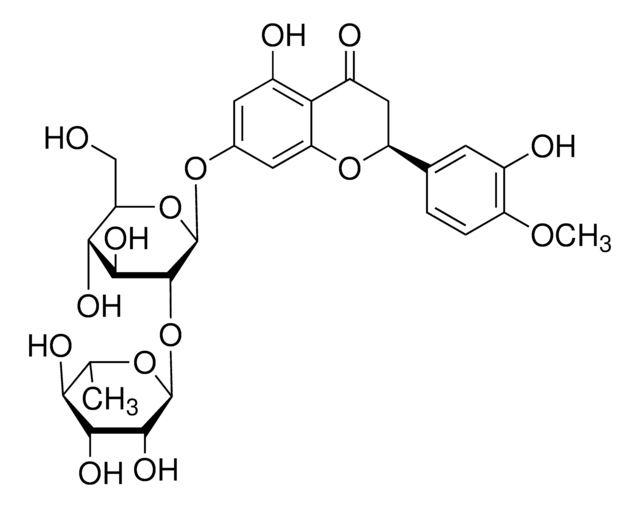L9647
Limonin
from citrus seeds, >90% (HPLC)
Synonyme(s) :
Citrolimonin, Dictamnolactone, Evodin, Limonoic acid 3,19:16,17 dilactone, Obaculactone
Sélectionner une taille de conditionnement
Sélectionner une taille de conditionnement
About This Item
Produits recommandés
Source biologique
citrus seeds
Niveau de qualité
Essai
>90% (HPLC)
Forme
powder
Application(s)
metabolomics
vitamins, nutraceuticals, and natural products
Température de stockage
2-8°C
Chaîne SMILES
CC1(C)O[C@H]2CC(=O)OC[C@]23[C@H]4CC[C@@]5(C)[C@@H](OC(=O)[C@H]6O[C@@]56[C@]4(C)C(=O)C[C@@H]13)c7ccoc7
InChI
1S/C26H30O8/c1-22(2)15-9-16(27)24(4)14(25(15)12-31-18(28)10-17(25)33-22)5-7-23(3)19(13-6-8-30-11-13)32-21(29)20-26(23,24)34-20/h6,8,11,14-15,17,19-20H,5,7,9-10,12H2,1-4H3/t14-,15-,17-,19-,20+,23-,24-,25+,26+/m0/s1
Clé InChI
KBDSLGBFQAGHBE-MSGMIQHVSA-N
Vous recherchez des produits similaires ? Visite Guide de comparaison des produits
Catégories apparentées
Description générale
Application
- to treat human peripheral blood mononuclear cells (PBMCs) to test its effect on human immunodeficiency virus (HIV) replication[3]
- to test its effects as an anti-osteoporosis agent in osteoblastogenesis activity in MC3T3-E1 cells and ovariectomized (OVX) rat model[4]
- as a reference standard in high-performance liquid chromatography (HPLC) system[5]
Actions biochimiques/physiologiques
Code de la classe de stockage
11 - Combustible Solids
Classe de danger pour l'eau (WGK)
WGK 3
Point d'éclair (°F)
Not applicable
Point d'éclair (°C)
Not applicable
Faites votre choix parmi les versions les plus récentes :
Certificats d'analyse (COA)
Vous ne trouvez pas la bonne version ?
Si vous avez besoin d'une version particulière, vous pouvez rechercher un certificat spécifique par le numéro de lot.
Déjà en possession de ce produit ?
Retrouvez la documentation relative aux produits que vous avez récemment achetés dans la Bibliothèque de documents.
Filtres actifs
Notre équipe de scientifiques dispose d'une expérience dans tous les secteurs de la recherche, notamment en sciences de la vie, science des matériaux, synthèse chimique, chromatographie, analyse et dans de nombreux autres domaines..
Contacter notre Service technique



